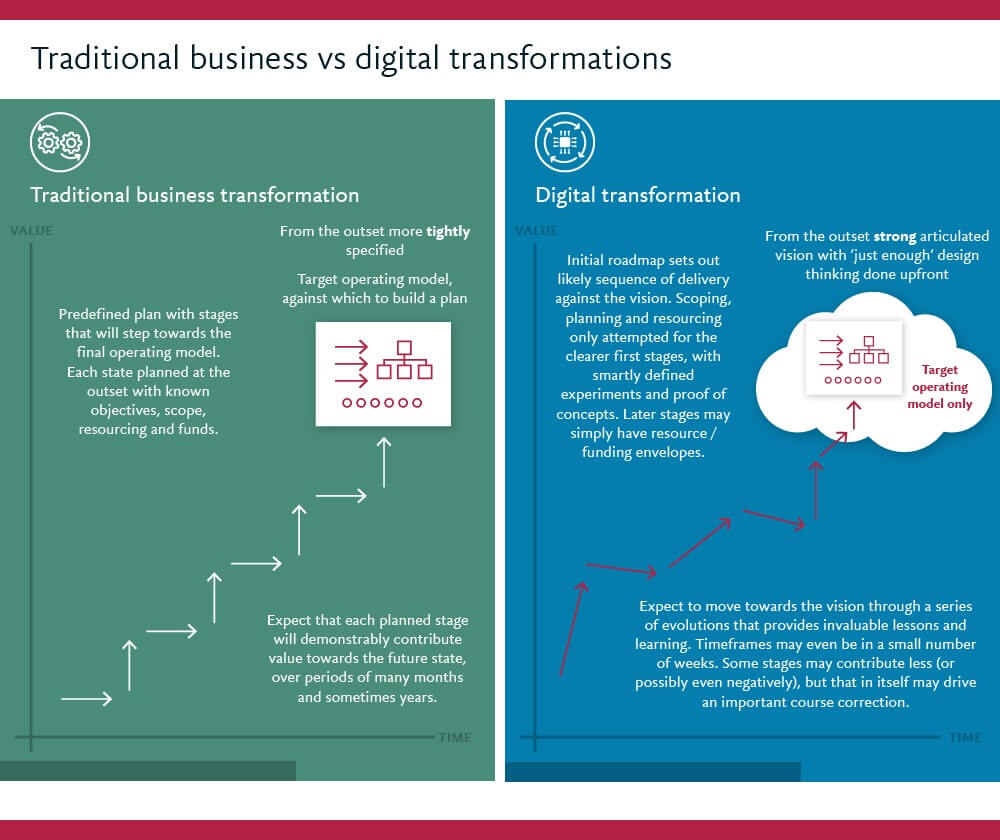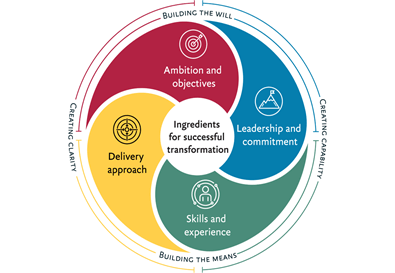While technology-enabled change is not new, the nature, pace of change and technologies available make digital transformation a very different prospect from traditional business transformations. The first vital step for any digital transformation programme leader is to be clear on these differences and navigate accordingly. In short, it’s time to get your digital head on.
Here are the four key differences between traditional business transformation and digital transformation that the programme leader needs to keep in mind.

1. A fluid sense of direction versus a fixed destination
In the traditional world of business transformation, you typically think long and hard about your final destination and define it early on through more detailed strategies and operating models to be clear about where you are going.
In the fast changing, fluid world of digital, this tends not to work. This is partly because digital innovation is moving so quickly, the possibilities will have moved on long before you get there so defining too much up-front is fruitless. It’s also partly because the technology permutations are so far reaching it is almost impossible to conceive where you will end up in a number of years.
Instead, you need to be comfortable with a less defined destination and a more exploratory mindset. Rather than spending months planning and designing at the outset, the trick is to do just enough thinking up front – just enough to give you some well understood guardrails for the journey to keep you from going off in the wrong direction.
These guardrails should include a well-articulated and strong vision, a defined set of goals to be achieved at the end of the journey (but not necessarily how it will be achieved), a set of guiding principles that guide future design and decision making, and a fit-for-digital business case.
Moreover, when setting off without a fully defined final destination, other elements of your journey become so much more important. Firstly, the product owners – if you are to make design decisions as you go, it is crucial you have empowered business people fully embedded in your team, able to make fast and reliable decisions every step along the way.
Secondly, understanding your minimum viable product (MVP) – without a fully defined destination, it is more important you understand the absolute minimum you need to deliver to users or customers (ideally for each delivery iteration). The temptation is always to go after more than the minimum, but strict focus on the must haves will test hypotheses and gather user feedback more quickly, enabling you to adjust accordingly and greatly increasing the chances of success.
Think calculated exploration rather than fixed road.
2. Funding to explore, learn and advance versus a set overall budget
The traditional world also leads to relatively straightforward funding conversations e.g. ‘We know what we need to achieve, we have a plan to achieve it, we need £x to get there over this timeframe, and we expect £y business benefits.’
Funding for digital transformation is much more about securing the resource to explore, experiment and learn. You’re not moving along a fixed road to a defined end point, so you can’t put a clear cost on the whole journey. Therefore, funding should be incremental with a sense of investing in a certain amount of development capability over a short period of time, and then seeing what you can achieve and learn from the investment.
This can often be uncomfortable for those still constrained by the traditional business planning cycles – typically finance – where the inevitable question is: ‘We can fund this next stage, but we need to understand how much the whole journey will cost’.
The reality for digital transformation programme leaders is you can’t always avoid this question, so your challenge becomes providing forecasts with clearly explained range-estimates of future cost (based on assumed levels of development capability) and then very quickly getting on with delivery so you can gather empirical evidence of how much you can deliver and for what.
With digital, you’re funding rapid, incremental innovation – it’s more akin to the R&D mindset.
3. A fit-for-digital business case as a living guide rather than a one-off detailed spreadsheet
The programme leader’s conversation with the sponsor of a traditional business transformation is very much about the economic rationale – the costs and benefits are written down in the business case, and the investment appraisal is clear. This is possible because you know these with a degree of accuracy at the beginning of the journey.
With digital, you don’t have this upfront certainty, so the conversation is necessarily more about buying into the vision, buying into the open-ended nature of where you may end up, seeking true support for the endeavour, the early experimental stages and the future possibilities.
Not all leaders in the business will find this easy, which is why the sponsors of digital transformation are so often the CEO, the strategy leadership or the marketing leadership. These are the roles most likely to focus on where the business needs to go to satisfy customers in the future, above and beyond short-term commercial and operational objectives.
To support this type of conversation, the programme leader still needs a business case – never let anyone convince you otherwise! But the business case is different. The focus is more on describing the future culture and capabilities the business will accomplish through digital, and less on quantifying benefit targets.
Putting this alongside cost forecasts based on range-estimates of future development capability will result in having an indicative investment appraisal. This is not a weaker business case, rather it reflects the nature of the digital transformation endeavour. The most important thing is that the business case articulates what you are trying to achieve and that the sponsor and programme leader use this to hold themselves to account.
For digital, the business case is different but it still exists.
4. Experiments versus pilots
In the traditional world, pilots are used primarily as a first step in a pre-defined journey. Pilots are about known unknowns. In the digital world, you test and experiment, embracing the pursuit of unknown unknowns. Try stuff out to learn. Be happy to alter the course in pursuit of the vision.
For example, a digital programme might aim to discover how far it can improve the business’s ability to predict future customer behaviour by accessing new external sources of digital media data on customers. But the business may not be sure if this external data will help. In such a case it may be better to run a small-scale technology experiment as quickly as possible, so you can rapidly access the data and start to learn, rather than take a long time choosing, architecting and implementing larger-scale technology in order to meet future scaling requirements only if the data proves useful.
This choice means that the initial investment in the small-scale technology is very contained. While this isolated decision may be perceived as being a ‘write off’, the resulting faster learning ensures larger-scale delivery efforts and costs only happen where you know customers and the business will gain.
The imperative is to move and learn quickly. This does not mean the experiments should be wild – they should be within the guardrails you have set out at the beginning. But their aim should be to develop capability, see what the impact is on users or customers, take stock and then go again.
Experiment fast, to learn quickly.











